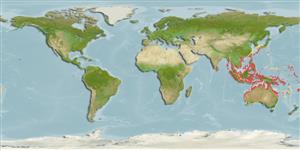>
Gobiiformes (Gobies) >
Gobiidae (Gobies) > Gobiinae
Etymology: Acentrogobius: Greek, a = without + Greek, kentron = sting + Latin gobius = gudgeon (Ref. 45335); moloanus: Named after its type locality, Molo, Iloilo, Panay I., Philippines.
More on author: Herre.
Environment: milieu / climate zone / depth range / distribution range
البيئة
بحري; مياه مخلوطة القاع. Tropical
Western Pacific: Ryukyu Islands, Philippines, Indonesia (Ref. 559) and Papua New Guinea (Ref. 6771). Occurs in the Mekong delta and probably ascends to the upper edge of the tidal zone in Cambodia (Ref. 12693).
الحجم / وزن / العمر
Maturity: Lm ? range ? - ? cm
Max length : 8.2 cm TL ذكر/ مختلط الجنس; (Ref. 125282); أعلا وزن تم نشرة: 5.90 g (Ref. 125282)
Occurs along tidal rivers and along coastlines. Feeds on small fishes and invertebrates (Ref. 12693).
Life cycle and mating behavior
النضج | التكاثر | وضع البيض | بيض | الخصوبة | Larvae
Rainboth, W.J., 1996. Fishes of the Cambodian Mekong. FAO species identification field guide for fishery purposes. FAO, Rome, 265 p. (Ref. 12693)
IUCN Red List Status (Ref. 130435: Version 2024-1)
استخدامات بشرية
أدوات
تقارير خاصة
Download XML
مصادر علي الأنترنت
Estimates based on models
Preferred temperature (Ref.
123201): 24.9 - 29.3, mean 28.6 °C (based on 2118 cells).
Phylogenetic diversity index (Ref.
82804): PD
50 = 0.5000 [Uniqueness, from 0.5 = low to 2.0 = high].
Bayesian length-weight: a=0.00692 (0.00361 - 0.01325), b=3.12 (2.96 - 3.28), in cm total length, based on LWR estimates for this species & Genus-body shape (Ref.
93245).
مستوى غذائي (Ref.
69278): 4.2 ±0.73 se; based on food items.
المرونه (Ref.
120179): عالي, الحد الزمني الأدني لتضاعف عدد أفراد المجتمع أقل من 15 شهر (Preliminary K or Fecundity.).
Fishing Vulnerability (Ref.
59153): Low vulnerability (10 of 100).
